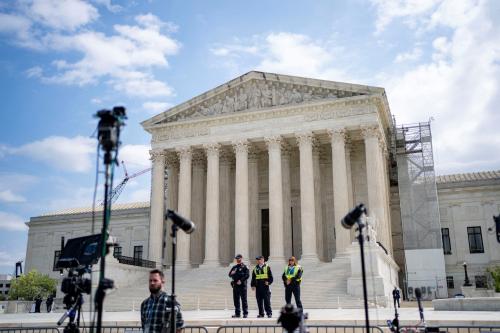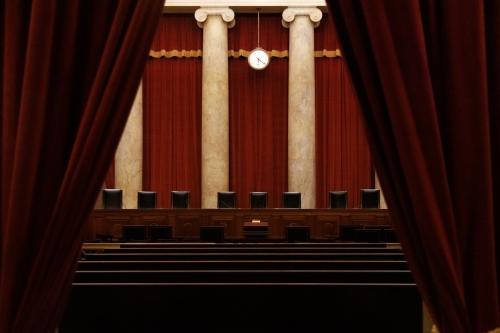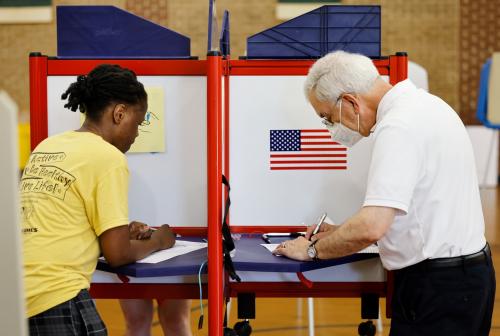In 2020, Joe Biden beat incumbent Donald Trump by 4.5 percentage points in the national popular vote but by a much narrower margin in the Electoral College.1 Will history repeat itself, or will Trump accomplish a feat seen only once before in American history—returning to the White House by defeating the man who turned him out of office in the previous election?
The national situation
Although polls do not reliably predict the outcome of elections far in the future, they do provide insight into the dynamics of these contests. They are more like X-rays than snapshots, helping us probe beneath the surface to assess trends in different parts of the electorate. Here’s what they are telling us now:
As of this week, President Biden trails former President Trump by about 1.5 percentage points in the average of national polls, which puts him roughly six points behind where he was on Election Day in 2020. A comparison of two Pew Research Center surveys—one analyzing the 2020 vote, the other conducted in April 2024—helps us understand where Biden has lost the most ground.
A comparison between these surveys indicates that the distribution of the white vote has remained fairly stable, in the aggregate and between those with and without college degrees. By contrast, major shifts away from Biden have occurred among Black, Hispanic, and Asian voters. Surprisingly, Trump appears to have gained more ground among college-educated Black and Hispanic voters than with less educated members of these groups. Equally surprising: Up to now, Trump has increased his support more among women than men. Whether this trend will survive a Democratic campaign heavily focused on abortion remains to be seen.
Also significant is the erosion of support for Biden among voters ages 30 to 49. This is the cohort most focused on family formation and most likely to become first-time homeowners, suggesting that the surging costs of child care and monthly mortgage payments may be reducing their support for the president.
Every recent survey shows that the state of the economy is the top issue for voters, followed by immigration. This emphasis usually reflects concerns about high unemployment, recessions, or slow growth. But as a recent survey shows, this year is different.
This finding helps explain why President Biden has received consistently low marks for his handling of the economy despite better-than-expected growth, vigorous job creation, unemployment below four percent and major new long-term investments in key economic sectors. It is consistent, moreover, with other surveys showing Americans more focused on price levels rather than the rate of price increases. The declining rate of inflation (disinflation) does nothing to lower the cost of food, gasoline, electricity, and housing. Americans are yearning for price decreases (deflation), which are unlikely to occur without a significant recession.
The situation in the swing states
Ever since the Constitution was ratified, national elections have been decided in the Electoral College. In recent decades, however, a new pattern has emerged: Fewer and fewer states are closely contested between the parties, while more and more are dominated by one of the parties. By 2020, only seven states were truly up for grabs, and Biden won six of them. As of now, however, he trails Trump in all seven (Table 2).
This table reveals several patterns that may affect the strategies of the presidential campaigns over the next six months. First, President Biden has less ground to make up in the “Blue Wall” states (Wisconsin, Michigan, and Pennsylvania) than he does in the South and Southwest. As we will see, high levels of concern about immigration may be damaging his prospects in Arizona and Nevada, while economic discontent seems to be inflicting higher-than-average damage on his standing in Georgia.
Second, despite carrying Michigan by the highest margin among the swing states he won in 2020, the president has lost more ground there than in the other Blue Wall states. This is crucial: If he ends up carrying these states, he probably will eke out a paper-thin margin of 270 to 268 in the Electoral College.2 But if he loses in Michigan, he will be forced to win one of the southern states (Georgia or North Carolina) or both the southwestern states (Arizona and Nevada), in all of which he currently has a steeper hill to climb than in Michigan.
A recent Bloomberg/Morning Consult survey of the swing states produced more than 5,000 pages of detailed data. Among the highlights: For these states in the aggregate, about half the voters selected either the economy or immigration as their top issue, compared to fewer than one in five who chose abortion or threats to democracy. By wide margins, Trump is more trusted to deal with the economy and immigration; by narrower margins, Biden is more trusted on abortion and democracy.
Data from individual states show higher concern about immigration in Arizona and Nevada, where 23% and 21% of the voters, respectively, chose it as their top issue. The other outlier was Georgia, where 41% selected the economy as their top concern.
Probing concerns about the economy in more depth, the Bloomberg/Morning Consult poll offered respondents a list of 15 factors than might be influencing their votes and asked them to choose their top three. Although the options ranged from traditional Democratic issues such as jobs, unemployment, and wages to traditional Republican issues such as taxes, government spending, and balanced budget, the top five named by the voters all addressed prices and costs.
While Trump leads on four of five top economic concerns, Biden has made an effective case for his efforts to contain health care costs by focusing on specifics such as insulin and prescription drugs. His challenge is to find equally compelling specifics in other economic arenas and to persuade voters that these efforts are making a difference in their lives.
Regarding Biden’s effort to turn around voter sentiment on the economy, the survey makes two key points. First, Biden cannot prevail by distinguishing between the national economy and conditions closer to home. Asked to compare the state of the economy under Biden and his predecessor, 36% said that the national economy is better under Biden, versus 52% who said it was better under Trump. But the results were similar for “your state” (35% to 49%), “your city or town” (34% to 48%), and “your personal situation” (32% to 51%). These results provide evidence against the hypothesis that negative media coverage is depressing the public’s assessment of the economy. Whatever may be the case at the national level, voters can see for themselves what is happening in their localities and personal lives.
Second, Biden cannot accomplish his mission by holding others responsible for the state of the economy. Although others play their part (especially Congress and corporations), by a substantial margin, more voters see the president as “very responsible” for economic conditions than any other institution. This should come as no surprise—since the late 1920s, presidents have been held responsible for the economy, and there is no reason to suppose that 2024 will be any different.
The impact of third party and independent candidacies
In 2016, independent and third-party candidates received six percent of the national popular vote, preventing Hillary Clinton from consolidating the anti-Trump forces behind her candidacy. She received only 48% of the vote, allowing Trump to win in the Electoral College with only 46%. In 2020, by contrast, third party and independent candidates garnered less than two percent of the vote, allowing Joe Biden to unify the opposition to Trump and win with an outright majority of more than 51%.
Will 2024 be more like 2016 or 2020, or will it be something altogether different? As of now, the evidence points to the third option. On the one hand, widespread discontent with both major-party candidates has opened a space for several alternatives, and Robert F. Kennedy Jr. is receiving double-digit support in the polls. Even if his support shrinks as the general election approaches, the odds are that non-major party candidates will receive a much higher share of the popular vote than they did four years ago.
On the other hand, current polls suggest that the net effect of these candidacies may be close to zero. At the national level, a comparison of recent surveys that assessed both the head-to-head Trump-Biden race and the five-way race including Robert F. Kennedy Jr., Green Party candidate Jill Stein, and independent Cornel West shows no significant differences: Trump leads Biden by 0.4% in the two-way race but trails him by 0.2% in the five-way contest.
This makes intuitive sense. As left-leaning candidates, Stein and West are more likely to draw from Biden, while fragmentary evidence suggests that Kennedy is drawing more from Trump. For example, the Quinnipiac survey conducted April 18 to April 24 found that RFK Jr. drew support from 12% of voters who supported Trump in a two-way contest, compared to seven percent from Biden supporters. By contrast, Stein and West together attracted six percent of Biden supporters versus just one percent from Trump. Combined, the three independent candidates drew 13% from each from each of the major party candidates. Similarly, an NBC survey fielded between April 12 and April 16 found that RFK Jr. attracted 15% of Trump voters compared to seven percent of Biden voters, while Stein and West voters came mostly from Biden supporters. The net effect of these candidacies could change if Kennedy’s support wanes, however.
Much the same pattern prevails in the swing states, as a comparison of two-way and five-way races from a recent survey shows.
Conclusion
There is more to the 2024 presidential election than the economy, of course. As the contest proceeds, Republicans will underscore public concerns about immigration. (They have recently coordinated their message, terming the situation an “invasion.”) Democrats will counter by underscoring public fears about the availability of abortions and threat to constitutional democracy. Some populist Republicans will be single-issue voters on immigration, as they were in 2016; some Democrats will be single-issue voters on abortion, as they have been in state and local contests since the Supreme Court’s decision overturning Roe v. Wade.
Organizational issues will also play a role in the outcome. Up to now, anyway, Democrats have enjoyed an advantage in fundraising, and turmoil in the Republican National Committee as well as key Republican state committees has slowed their efforts to create effective get-out-the-vote campaigns in key states.
The attributes of the candidates will matter as well. President Biden will be hurt if he speaks or acts in ways that heighten public concerns about his age. Former President Trump will pay a price among swing voters if he indulges in reckless speech that heightens concerns about his character or is convicted on felony charges in one or more of the court cases he faces.
Political events yet to come could make a difference too. If the war in Gaza continues, pro-Palestinian activists are planning to take mass demonstrations to the Democratic National Convention, threatening a replay of the disorder in 1968 that damaged Hubert Humphrey’s campaign. If there are debates, they could prove decisive, as they did in some previous presidential contests. “October surprises” are always possible. Many Americans who will end up voting in November haven’t really begun to tune into the race or focus on their choice. When they do, sentiment could shift substantially.
For now, however, Donald Trump enjoys an edge over Joe Biden. The president’s challenge is to clearly assess the obstacles he faces, blunt their effect as much as possible, and then go on offense against his opponent. One thing is clear: It will be the fight of his life, against a man determined to win at all costs.
-
Footnotes
- A shift of fewer than 44,000 votes in Arizona, Georgia, and Wisconsin out of the 11.4 million cast for the major-party candidates in these states would have produced a 269-269 electoral vote tie and thrown the election into the House of Representatives, where Trump probably would have won.
- His total includes an electoral vote from Nebraska’s 2nd congressional district, because Nebraska is one of only two states that award some of their electoral votes to the winners of each congressional district. This explains why Nebraska Republicans recently tried unsuccessfully to switch to a winner-take-all system—and why they are likely to try again before November. If they succeed, the Blue Wall scenario would produce a tie in the Electoral College, making the outcome of the House elections crucial to determining the winner of the presidential contest.







Commentary
President Biden trails former President Trump. Can he come back?
May 1, 2024